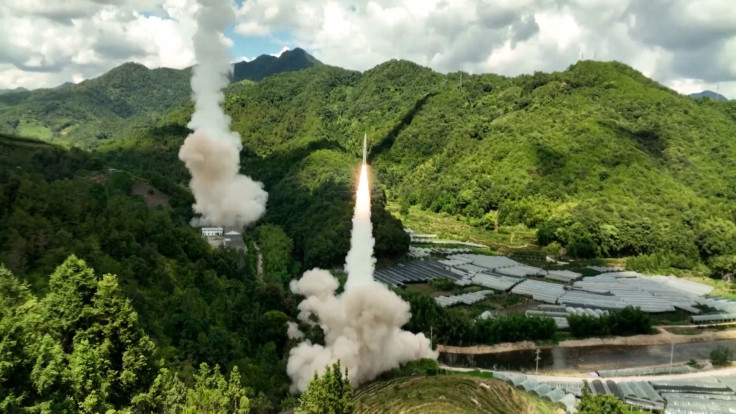Taiwan Invasion: China Has Developed The Firepower To Knock Out Guam, Sink US Carriers
KEY POINTS
- PLA has tailored its capabilities to defeat any U.S. intervention in Taiwan
- The DF-26B, a carrier-killer missile, can reach beyond the Guam base
- A strike on Guam could remove significant U.S. combat power from the battle for Taiwan
If the recent live-fire drills conducted by China's People's Liberation Army (PLA) near and around the Taiwan Strait are any indication, the tables have turned in the Indo-Pacific. From being a minor force unable to counter the U.S. military's might during the 1996 Taiwan Strait crisis, the PLA has grown into a force that can go toe to toe with any force the U.S. military can field in the South China Sea, thus sealing Taiwan's fate if hostilities break out.
Regional defense analysts point out that China had rebuilt its military to defeat any U.S. intervention in the Taiwan Strait. The 1996 crisis was an embarrassment to the PLA and the Chinese Communist Party bosses. The United States sent two aircraft carrier strike groups, led by the USS Independence and USS Nimitz, into the area, one of them even transiting the strait. There was little China could do.
Things have changed since. The PLA now focuses its combat tactics on anti-access/area denial (A2/AD), a strategy aimed to "dissuade, deter, or, if ordered, defeat third-party intervention." The PLA has developed a clutch of missiles that can "degrade the survivability" of U.S. aircraft carriers and the air bases on Guam, which analysts claim will be the ground zero in any U.S.-China conflict.
Case in point, the DF-21D and DF-26B, dubbed carrier-killer missiles. These weapons have within their range the whole of the South China Sea, Taiwan Strait, and Northeast Asia. They are designed to destroy even the largest of U.S. Navy ships. China is estimated to have 300 DF-26 intermediate-range ballistic missiles with an estimated range of nearly 2,500 miles, capable of striking Guam and any U.S. Navy ships within that range, according to the Defense Department's latest report on Chinese military power.
Guam is regarded as a "permanent aircraft carrier" with tremendous firepower. It also holds some of the most significant ammunition and fuel storage capabilities, key intelligence, surveillance, and reconnaissance (ISR) solutions of the U.S. Navy. An effective Chinese strike there would severely hamper the U.S. military's ability to bring significant combat power to the fight, at least initially, experts said. And that is key, because by the time more U.S. troops and weapons can be moved in, Taiwan would be firmly in Chinese hands.
Collin Koh, a research fellow at Singapore's Institute of Defense and Strategic Studies, said the PLA has acquired the capabilities to target U.S. Navy carrier strike groups.
"Known PLA ballistic missile capabilities, especially the DF-26, were believed to possess the range to reach Guam, and in its anti-ship role alongside the DF-21D, can target the U.S. Navy carrier strike groups," Koh told International Business Times. "In theory, besides these kinetic capabilities, it is plausible to also assess that the PLA has acquired certain intelligence, surveillance and reconnaissance (ISR) capabilities that are crucial for targeting purposes to support these missile launches."
Though the U.S. Navy has worked to come up with countermeasures, defending its ships and assets from a swarm of Chinese missiles won't be easy — after all, it is easier to destroy a target than to defend one.
Koh said recent adjustments to force posture and training undertaken by the U.S. military forces in the Western Pacific, especially the Indo-Pacific Command and the forward-deployed U.S. Navy elements of the Pacific Fleet, seem designed to address these challenges from the PLA.
The U.S. is also strengthening its defenses on Guam, where the Pentagon is investing more than $11 billion in military construction over the next five years.
China's missile programs have always been shrouded in secrecy, and there is a lot that is known for certain about the PLA's actual capabilities. "There're certainly unknowns that we may not have clear answers to, for example, how these missile systems integrate and whether they work effectively within a complex, networked kill chain. And the training of proficient personnel required to operate these systems," Koh added.

© Copyright IBTimes 2025. All rights reserved.





















